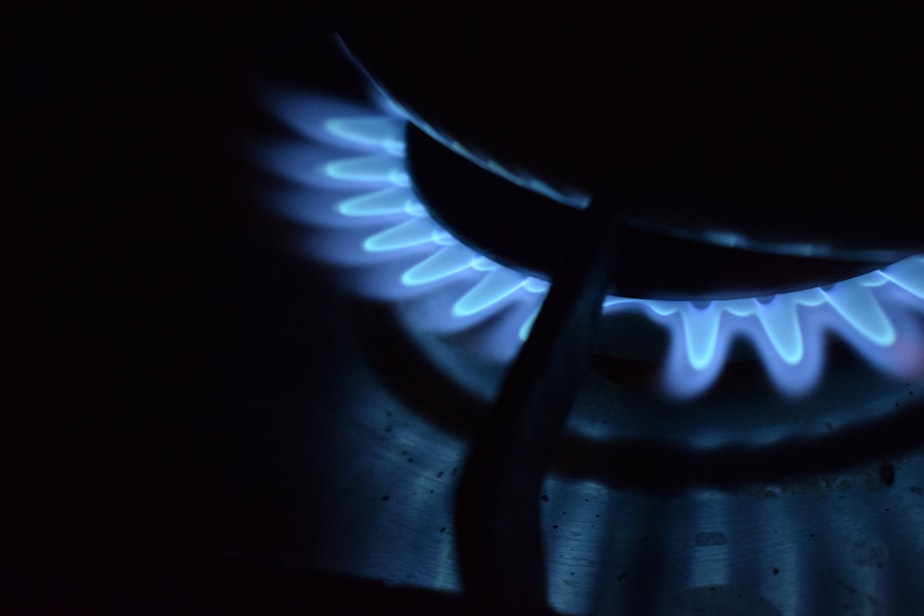Turning up the heat on gas appliances: why federal regulations could get tighter

For many Americans, the distinctive clicking sound of a gas burner turning on means something delicious is on the way.
Roughly a third of U.S. homes have gas stoves.
However, climate scientists and some public health experts say that’s a problem: burning natural gas contributes carbon to the atmosphere, and emissions from gas stoves have been linked asthma in children and other health risks.
Seattle banned most gas appliances in new buildings when the city revised its energy code in 2021. But cooking gas is still allowed.
Now, federal regulators may be turning up the heat on gas appliances.
Richard Trumka, a commissioner with the U.S. Consumer Product Safety Commission said last month that the agency plans to begin a formal review process that could lead to tighter regulations on gas stoves.
“Unfortunately, the vast majority of Americans have no idea that every time they cook, they could be subjecting themselves and their loved ones to toxic chemicals," Trumka said.
Also last month, Senators and members of Congress, including Patty Murray of Washington (D), urged the commission to raise safety standards for gas cooktops.
Sponsored
They pointed out that Black, Latino, and low-income households are most at-risk for exposure to noxious air pollution, and least likely to have sufficient ventilation in the kitchen.
If you have a gas stove, those pollutants are likely a silent presence in your home, even when you’re not cooking.
Dr. Eric Lebel is a senior scientist at PSE Healthy Energy, an Oakland-based nonprofit science and policy institute. When Lebel was a grad student at Stanford, he led research testing 53 gas stoves ranging in age from 0 to 30 years.
“We found that nearly every stove had a detectable amount of emissions while it was off," Lebel explained.
Three quarters of the methane emissions from the stoves were leaked when they weren’t in use. Using natural gas also leads to other byproducts, like nitrogen dioxide, which is a respiratory irritant.
Sponsored
"There's carcinogens like benzene," Lebel continued. "And if you're exposed to a gas leak, whether from your gas stove or from another appliance inside your house, not only is that contributing to climate change, but it can also be damaging to your health as it contributes to indoor air quality concerns as well."
So where does this leave the culinary world?
Gas ranges have long been the gold standard for serious home cooks and professionals, because that blue flame provides a lot of control and speed. But that assumption – that gas is always best – may be changing.
Jill Lightner is a food writer based in Seattle. She’s the author of several books, including “Scraps, Peels and Stems: Recipes and Tips for Rethinking Food Waste at Home.”
Last year, she wrote about her switch from gas to induction cooking for The Seattle Times. Lightner joined Soundside to tell the story about her journey to using induction cooking.
Sponsored
Trade groups advocating on behalf of energy companies that deliver natural gas, such as the American Gas Association, have pushed back on criticism of natural gas cooking, citing that methane emissions from natural gas systems have declined significantly over the past 30 years.
Consumer Reports, the independent, nonprofit organization and publication, has begun doing testing for indoor emissions from gas stoves.
Ashita Kapoor is the Associate Director of Product Safety for Consumer Reports. She says they’ve looked into a number of potentially harmful byproducts caused by gas stoves, and found some results are indeed above international guidelines.
Still, Kapoor says the publication is not ready to recommend against buying a natural gas stove.
"I think the main message is that Consumer Reports can just recommend the use of the range hood," Kapoor explained. "In conjunction with any form of ventilation, based on our studies has shown positive effects."
Sponsored
Kapoor said that Consumer Reports' survey data shows that only 13% of Americans use range hoods, which help capture emissions generated by cooking.
"If we can drive that number up, I think that would be a significant progress."
You can listen to the entire segment, including our extended conversation with Jill Lightner in the audio above.





